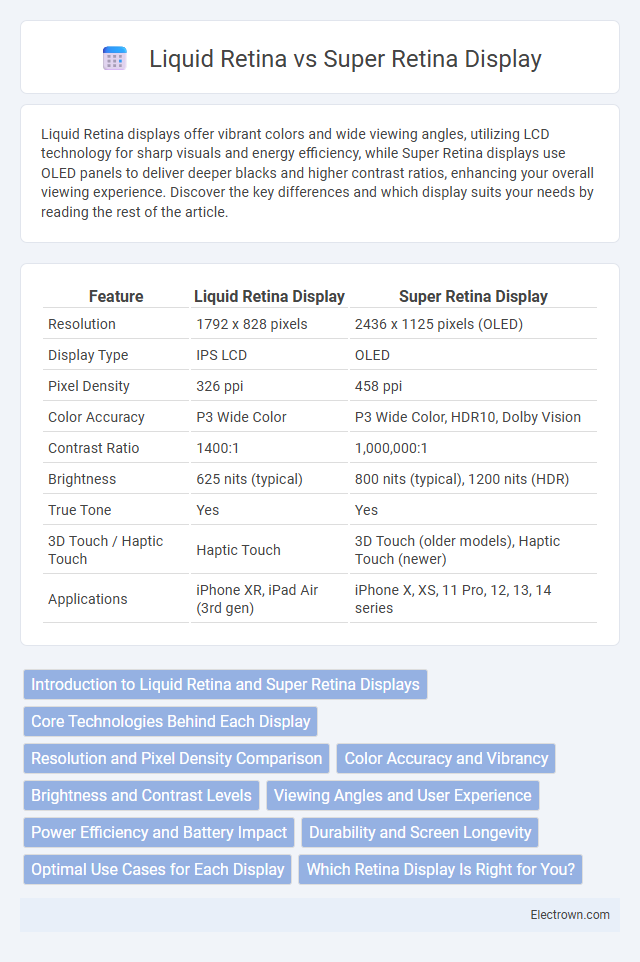Liquid Retina displays offer vibrant colors and wide viewing angles, utilizing LCD technology for sharp visuals and energy efficiency, while Super Retina displays use OLED panels to deliver deeper blacks and higher contrast ratios, enhancing your overall viewing experience. Discover the key differences and which display suits your needs by reading the rest of the article.
Table of Comparison
| Feature | Liquid Retina Display | Super Retina Display |
|---|---|---|
| Resolution | 1792 x 828 pixels | 2436 x 1125 pixels (OLED) |
| Display Type | IPS LCD | OLED |
| Pixel Density | 326 ppi | 458 ppi |
| Color Accuracy | P3 Wide Color | P3 Wide Color, HDR10, Dolby Vision |
| Contrast Ratio | 1400:1 | 1,000,000:1 |
| Brightness | 625 nits (typical) | 800 nits (typical), 1200 nits (HDR) |
| True Tone | Yes | Yes |
| 3D Touch / Haptic Touch | Haptic Touch | 3D Touch (older models), Haptic Touch (newer) |
| Applications | iPhone XR, iPad Air (3rd gen) | iPhone X, XS, 11 Pro, 12, 13, 14 series |
Introduction to Liquid Retina and Super Retina Displays
Liquid Retina and Super Retina displays are advanced screen technologies developed by Apple, designed to enhance visual experience on iPhones and iPads. Liquid Retina features a high-resolution LCD with accurate color reproduction and True Tone technology, optimizing display brightness and reducing eye strain. Super Retina employs OLED panels, offering deeper blacks, higher contrast ratios, and HDR support for more vibrant and lifelike images.
Core Technologies Behind Each Display
Liquid Retina displays utilize advanced IPS LCD technology combined with True Tone and wide color (P3) support, delivering accurate colors and uniform brightness across the screen. Super Retina displays leverage OLED technology, offering higher contrast ratios, true blacks, and HDR support with individually lit pixels for superior image quality. Your choice between these displays affects color accuracy, brightness, and energy efficiency depending on your visual preferences and usage needs.
Resolution and Pixel Density Comparison
Liquid Retina displays feature a resolution of 1792 x 828 pixels with a pixel density of approximately 326 pixels per inch (PPI), while Super Retina displays offer higher resolutions such as 2436 x 1125 pixels and pixel densities reaching up to 458 PPI. The increased pixel density in Super Retina screens ensures sharper, more detailed images and smoother text rendering, enhancing visual clarity for your viewing experience. Choosing a Super Retina display results in notably crisper visuals compared to the Liquid Retina, especially noticeable in high-definition content and fine detail work.
Color Accuracy and Vibrancy
Liquid Retina displays offer impressive color accuracy with True Tone technology, delivering natural and consistent colors ideal for everyday use and content consumption. Super Retina displays enhance vibrancy through OLED technology, providing deeper blacks and higher contrast ratios that result in more vivid and lifelike images. The superior color gamut and contrast of Super Retina displays make them preferred for professional photo and video editing where precise color representation is critical.
Brightness and Contrast Levels
The Liquid Retina display typically offers a brightness level of around 625 nits, while the Super Retina display achieves up to 800 nits or higher, enhancing visibility in bright environments. Contrast ratio in Liquid Retina panels is approximately 1400:1, whereas Super Retina displays feature OLED technology with superb contrast ratios of 1,000,000:1, delivering deeper blacks and more vivid colors. These differences make Super Retina displays superior for media consumption and detailed image rendering due to higher brightness and significantly better contrast performance.
Viewing Angles and User Experience
Liquid Retina displays feature IPS LCD technology, offering wide viewing angles with consistent color accuracy and brightness, enhancing your viewing experience from various positions. Super Retina displays, using OLED technology, provide superior contrast ratios and deeper blacks, maintaining vibrant colors even at extreme viewing angles. Both deliver excellent user experience, but Super Retina screens excel in immersive visuals, especially in low-light environments.
Power Efficiency and Battery Impact
Liquid Retina displays utilize IPS LCD technology, which generally consumes less power than OLED used in Super Retina displays, especially when showing bright and varied colors. Super Retina OLED displays offer deeper blacks and higher contrast by turning off individual pixels, potentially reducing battery drain during dark mode or predominantly black content usage. Your device's battery life can benefit from the Liquid Retina's consistent power draw in bright environments, while Super Retina excels in power efficiency with darker visuals.
Durability and Screen Longevity
Liquid Retina displays utilize LCD technology with enhanced pixel density and color accuracy, offering solid durability with less susceptibility to burn-in compared to OLED-based Super Retina displays. Super Retina screens feature OLED panels known for deeper blacks and higher contrast but face potential longevity issues such as organic material degradation and burn-in over time. When considering screen longevity, Liquid Retina provides a more resilient experience for prolonged use, whereas Super Retina delivers superior visual quality with careful usage to maintain durability.
Optimal Use Cases for Each Display
The Liquid Retina display offers vibrant colors and accurate visuals, making it ideal for everyday tasks, casual media consumption, and productivity apps where battery efficiency is vital. The Super Retina display excels in high contrast, deep blacks, and HDR content, providing an immersive experience for photo editing, video playback, and gaming enthusiasts. Your choice depends on whether you prioritize energy savings with solid color accuracy or the richest visual detail and dynamic range.
Which Retina Display Is Right for You?
Choosing between Liquid Retina and Super Retina displays depends on your preferences for resolution and color accuracy. Super Retina offers higher pixel density and OLED technology, delivering deeper blacks and more vibrant colors, ideal for users prioritizing cinematic visuals and contrast. Your decision should align with whether you value battery efficiency and affordability in Liquid Retina or premium display quality in Super Retina.
Liquid Retina vs Super Retina Display Infographic

 electrown.com
electrown.com